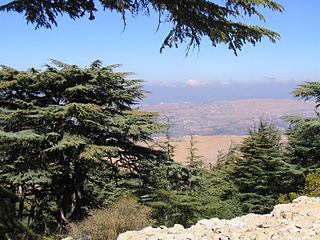
Cedrus, with the common English name cedar, is a genus of coniferous trees in the plant family Pinaceae. They are native to the mountains of the western Himalayas and the Mediterranean region, occurring at altitudes of 1,500–3,200 m (4,900–10,500 ft) in the Himalayas and 1,000–2,200 m (3,300–7,200 ft) in the Mediterranean.

Pinus radiata, the Monterey pine, insignis pine or radiata pine, is a species of pine native to the Central Coast of California and Mexico. It is an evergreen conifer in the family Pinaceae.
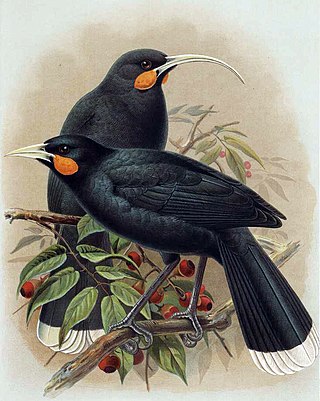
The huia is an extinct species of New Zealand wattlebird, endemic to the North Island of New Zealand. The last confirmed sighting of a huia was in 1907, although there was another credible sighting in 1924.
Ironwood is a common name for many woods that have a reputation for hardness, or specifically a wood density that is denser than water, although usage of the name ironwood in English may or may not indicate a tree that yields such heavy wood.

Cunninghamia is a genus of one or two living species of evergreen coniferous trees in the cypress family Cupressaceae. They are native to China, northern Vietnam and Laos, and perhaps also Cambodia. They may reach 50 m (160 ft) in height. In vernacular use, it is most often known as Cunninghamia, but is also sometimes called "China-fir". The genus name Cunninghamia honours Dr. James Cunningham, a British doctor who introduced this species into cultivation in 1702 and botanist Allan Cunningham.

Vitex lucens, or pūriri, is an evergreen tree endemic to New Zealand.

Abies amabilis, commonly known as the Pacific silver fir, is a fir native to the Pacific Northwest of North America, occurring in the Pacific Coast Ranges and the Cascade Range. It is also commonly referred to in English as the white fir, red fir, lovely fir, amabilis fir, Cascades fir, or silver fir.

Intsia bijuga, commonly known as Borneo teak, ipil, Johnstone River teak, and kwila, amongst many other names, is a species of tree in the flowering plant family Fabaceae, native to coastal areas from east Africa, through India and Southeast Asia to Australia and the western Pacific. It has significant importance to indigenous cultures in many parts of its range, but is also threatened by illegal logging due to its high quality timber. It is most commonly found in tropical coastal forests.

Syzygium maire, commonly known as the swamp maire, is an evergreen tree endemic to New Zealand. It is found throughout the North Island, and the top of the South Island. The Māori language name is maire tawake. Swamp maire grows in wetlands, where it develops breathing roots in waterlogged soils, but is also tolerant of reasonably dry situations. The creamy-white flowers in autumn are followed by bright red drupes around 3 cm in length in late winter. The fruit are edible and can be eaten raw or cooked. The fruits are rich in antioxidants. Swamp maire is sold for use in gardens as an ornamental plant. It is not related to other species called maire, which are in the genus Nestegis.

Nestegis apetala is a small tree native to northern New Zealand and to Norfolk Island. The common names in New Zealand are coastal maire or broad-leaved maire. On Norfolk Island, the common name is ironwood. The species name apetala refers to the lack of petals on the flowers.

Nestegis is a genus of flowering plant in the olive family, Oleaceae. There are five currently accepted species in the genus: three species are endemic to New Zealand, while one can be found on New Zealand and Norfolk Island. Another is restricted to Hawaiʻi.

Nestegis sandwicensis, commonly known as Hawai'i olive or olopua, is a species of flowering tree in the olive family, Oleaceae, that is endemic to Hawaii. It is found on all major islands at elevations of 30–1,300 m (98–4,265 ft) in coastal mesic and mixed mesic forests, and, especially, dry forests. It usually reaches a height of 6 m (20 ft) with a trunk diameter of 0.2 m (0.66 ft), but may reach 20 m (66 ft) in height with a trunk diameter of 0.9 m (3.0 ft).
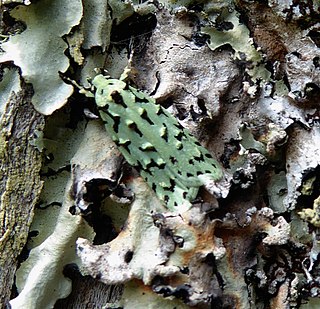
Izatha peroneanella, also known as the small lichen moth or the green lichen tuft, is a moth of the family Oecophoridae. It is endemic to New Zealand, where it is found throughout the North Island, other than the Aupouri Peninsula of Northland.
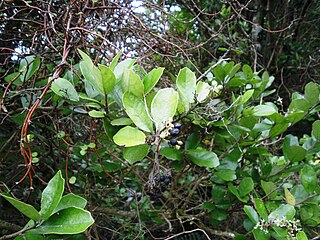
Pennantia corymbosa, commonly known as kaikomako, is a small dioecious tree endemic to New Zealand.

Nestegis cunninghamii, commonly called black maire is a native tree of New Zealand.
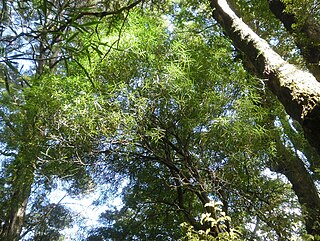
Nestegis montana, commonly called narrow-leaved maire, is a tree native to New Zealand.
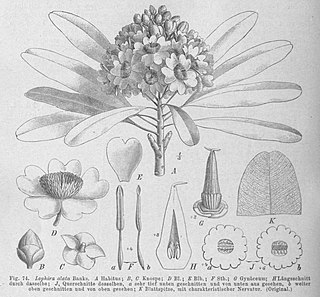
Lophira lanceolata, commonly known as the dwarf red ironwood, is a species of tree in the family Ochnaceae which is native to tropical West and Central Africa. The timber is used for heavy construction, an edible oil can be extracted from the seeds and various parts of the plant are used in traditional medicine.

Tupeia is a monotypic genus of semi-parasitic shrubs (mistletoes) which occurs in both the North and South Islands of New Zealand. There is only one species in the genus: Tupeia antarctica. There are no synonyms.


















